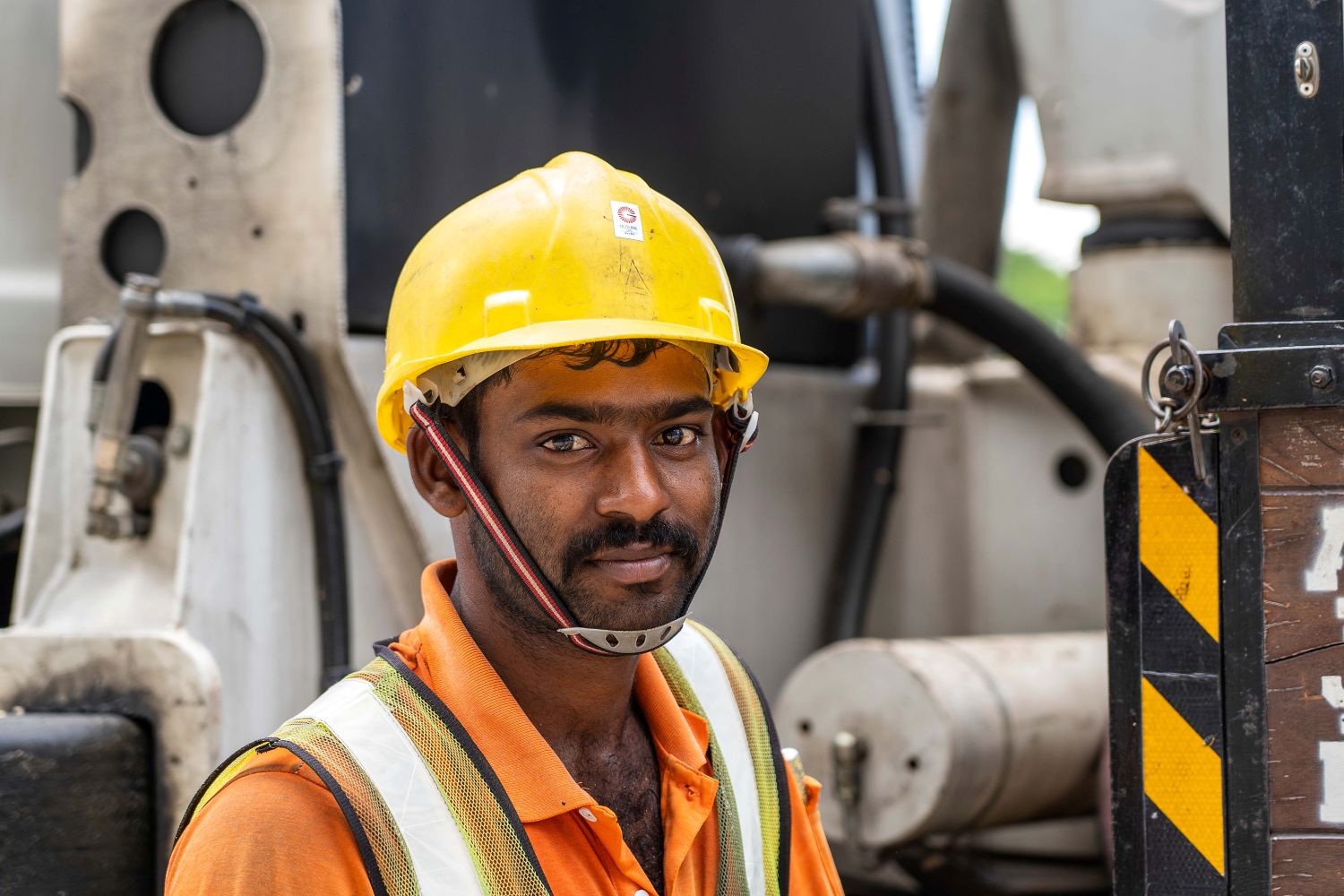Temporary migrant labour in construction and the unspoken realities
The global construction industry frequently relies on a workforce that often remains invisible to public scrutiny - temporary migrant labour. Beyond the official statistics concerning legal status, this segment of the workforce can face significant wage disparities, disproportionate safety risks and precarious working conditions. Despite these challenges, their contribution is unequivocally critical to maintaining project timelines, managing costs and filling essential skills gaps across the supply chain, making them an indispensable, yet often overlooked, component of the industry's operational fabric, writes John Ridgeway.
The reliance on migrant labour in construction is not a recent phenomenon, nor is it confined to any single nation. From the skyscrapers of Dubai and London to infrastructure projects in rapidly developing economies, temporary migrant workers form a substantial, often unquantified, portion of the workforce. Driven by economic disparities between their home countries and host nations and the promise of higher wages, individuals migrate to fill roles that native workforces may be unwilling or unavailable to undertake. These roles often involve physically demanding, low-skilled work, but also extend to skilled trades where domestic shortages persist.
In the United Kingdom, for instance, a significant number of construction projects, particularly in major urban centres, still depend on workers from various European Union countries, and increasingly, from beyond the EU following post-Brexit immigration policy changes. Similar patterns are observed in the United States, where Latin American migrant workers are a bedrock of many construction sectors and in the Middle East, where South Asian and African labourers form the vast majority of the on-site workforce. Australia and Canada also attract significant numbers of temporary migrant workers to support their construction booms. This global reliance underscores the fundamental economic reality that migrant labour provides flexibility and a readily available supply of manpower crucial for the cyclical and project-based nature of construction.
The shadow economy of wage disparity
One of the most profound and persistent issues confronting temporary migrant workers in construction is the prevalence of significant wage disparity. While official employment laws in many host countries mandate equal pay for equal work, the reality on the ground often diverges considerably. Migrant workers, particularly those with precarious legal status or those reliant on unscrupulous labour brokers, are often susceptible to exploitation. They may be paid below minimum wage, denied overtime pay, or subjected to arbitrary deductions. Their limited understanding of local labour laws, fear of deportation, or desperate need for income can prevent them from challenging these exploitative practices.
This disparity creates a shadow economy within the construction sector. Companies that exploit these wage gaps gain an unfair competitive advantage, undercutting more ethical firms. This drives down overall labour costs, but at the expense of human dignity and fair market competition. The problem is exacerbated by complex subcontracting chains, where main contractors may lack direct oversight of the payment practices of their sub-tier suppliers. Wages can be siphoned off by intermediaries, leaving the workers with a fraction of what they were promised or what constitutes fair remuneration in the host country. This economic exploitation is a direct contributor to the hidden profits of some construction operations, but it inflicts profound social and personal costs on the individuals involved.
Unacceptable safety risks
The issue of safety within construction is paramount, given its inherently hazardous nature. However, temporary migrant workers often face disproportionately higher safety risks compared to their permanent, domestic counterparts. Several factors contribute to this dangerous reality.
Firstly, language barriers can impede understanding of critical safety instructions, site warnings and emergency procedures. Even if safety briefings are conducted, a lack of proficiency in the local language can lead to misinterpretations or a complete failure to comprehend vital information, putting workers at immediate risk.
Secondly, migrant workers, especially those with limited experience in the host country's construction practices, may lack familiarity with specific health and safety regulations, equipment operation protocols, or site-specific hazards. Training provided might be insufficient, rushed, or not adapted to their linguistic or cultural context. Desperate to maintain employment, they may be less likely to question unsafe practices or refuse dangerous tasks, fearing reprisal or job loss.
Thirdly, their temporary or irregular employment status often means they have less access to proper safety equipment, adequate training, or comprehensive medical support compared to permanent staff. They might be assigned to the most dangerous tasks without sufficient preparation or supervision. Employers, aware of their precarious position, may take shortcuts on safety measures, knowing that workers are less likely to report violations due to their vulnerability. This systemic neglect of safety protocols for this segment of the workforce contributes significantly to injury rates, long-term health issues and tragically, fatalities on construction sites globally. The human cost of these safety failures extends far beyond the individual, impacting families and communities in their home countries.
Precarious working conditions and lack of rights
In addition to wage disparity and safety, temporary migrant labourers frequently endure precarious working conditions that undermine their fundamental rights. This includes excessively long working hours without appropriate compensation, limited access to grievance mechanisms and a lack of employment benefits such as sick leave, holiday pay, or pension contributions. Accommodation provided by employers may be substandard, overcrowded and unsanitary, further eroding their well-being.
Their dependence on employment for visa status often renders them vulnerable to exploitation. Threats of contract termination or visa cancellation can be used by unscrupulous employers to coerce workers into accepting sub-optimal conditions. Access to legal aid or union representation may be limited due to financial constraints, linguistic barriers, or fear of repercussions. This lack of robust protection mechanisms means that temporary migrant workers often operate in a legal and social vacuum, leaving them exposed to abuse with little recourse.
The absence of a stable support network in a foreign country exacerbates their vulnerability. They may struggle with cultural assimilation, social isolation and the psychological burden of being far from family, making them even more susceptible to exploitation. This precariousness is often an unacknowledged cost built into the construction model, enabling projects to progress with lower direct labour costs, but at a significant hidden human price.
Despite these formidable challenges, the contribution of temporary migrant labour to the construction supply chain is undeniably critical. They fill vital skills gaps, particularly in manual trades and specialised areas where domestic labour shortages exist. Their flexibility allows contractors to scale their workforce up or down rapidly in response to project demands, managing the inherently fluctuating nature of construction work. Without this adaptable pool of labour, many large-scale infrastructure projects, commercial developments and residential builds would face significant delays, cost overruns, or even be rendered unfeasible.

Migrant workers often accept roles that domestic workforces may deem undesirable due to their physical demands, low pay (relative to domestic standards), or temporary nature. This willingness to undertake arduous tasks ensures that construction sites remain operational and productive. Their presence helps maintain competitive labour costs within the industry, which, while often leading to exploitation, also contributes to project affordability and economic viability for contractors. They are the unseen backbone of many construction operations, ensuring the continuity of work from foundation to finishing.
In specific sectors, such as scaffolding, concrete pouring, or certain specialist installations, migrant workers often form the majority of the skilled labour force. Their collective expertise and tireless efforts enable the timely delivery of complex project components, directly impacting project timelines and overall delivery success. The efficiency gains derived from their availability and dedication are often taken for granted by project stakeholders who may not fully comprehend the challenging circumstances under which these essential contributions are made.
Moving towards ethical practices and recognition
Addressing the issues surrounding temporary migrant labour in construction requires a concerted effort from governments, industry bodies, main contractors and clients. It necessitates moving beyond mere compliance with basic labour laws to adopting genuinely ethical sourcing and employment practices.
Main contractors and clients must implement rigorous due diligence throughout their supply chains to ensure ethical recruitment practices, fair wages and safe working conditions for all workers, regardless of their employment status or origin. This involves auditing subcontractors' labour practices, ensuring transparency in payment flows and establishing clear contractual obligations regarding worker welfare.
Creating more transparent employment and payment systems can also help combat exploitation. This includes direct payment to workers, clear contracts in their native languages and accessible grievance mechanisms that are independent of employers. Investing in language training and cultural orientation programmes for migrant workers can further improve safety comprehension and social integration. Providing access to interpreters on site is also crucial for critical safety briefings.
Ensuring migrant workers have unhindered access to legal aid, trade union representation, and independent support services is also vital for empowering them to report abuses without fear of reprisal. Governments must enforce labour laws effectively and provide clear pathways for reporting exploitation. Fundamentally, there needs to be a broader recognition and valuation of the critical role played by temporary migrant labour. Acknowledging their contribution openly and working towards equitable remuneration and safe conditions should be seen not just as a moral imperative, but as a strategic business decision that enhances industry reputation, reduces social risks and contributes to a more sustainable workforce.
The construction industry's reliance on temporary migrant labour is a complex reality. While these workers are indispensable to global construction activity, their vulnerability to wage disparity, safety risks, and precarious conditions represents a silent, ongoing crisis. Confronting these unspoken realities and implementing robust ethical practices is essential for ensuring that the foundations of our built environment are not built on the exploitation of its most unseen and vulnerable workers.
Additional Blogs

How construction can cut Its carbon footprint by caring for soil
Soil is often dismissed as mere dirt, but it is one of the planet’s most powerful carbon stores, holding more than all of the world’s forests combined. Yet in our rush to build, pave and develop, we...
Read moreWhat is bridging damp? How it happens and how to fix it
Bridging damp happens when moisture finds a path around the building’s damp-proof course (DPC) so it reaches your internal walls and skirting. If you see damp patches rising above the skirting or...
Read more

The silent death of the fixed-price contract
For decades, the fixed-price contract has been the backbone of construction procurement. It promised certainty with a defined scope, an agreed sum and a clear transfer of risk from client to...
Read more